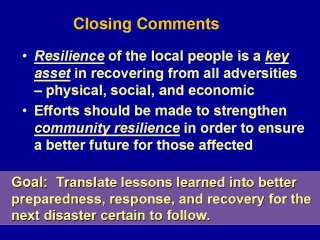 |
The goal of a
public health response to disasters is to respond rapidly, minimize the
impact on health, and facilitate activities that can be sustained throughout
the recovery period. While numerous resources and personnel in response to a
large scale disaster come from international aid organizations and
volunteers, it is important to note that immediately following a sudden
disaster such as a tsunami or earthquake, most lives are saved by the
courage and resourcefulness of friends and neighbors. Preparedness efforts
need to take into account the capacity of community resilience and develop
ways to strengthen the ability to recover from the full spectrum of the
adversities and build on this to ensure a return to an even better life than
before. We are hopeful for continued recovery towards a better future for
the communities affected by the Indian Ocean tsunami disaster and for
communities recovering from disasters that occurred prior to December 26,
2004 or afterwards.
|
